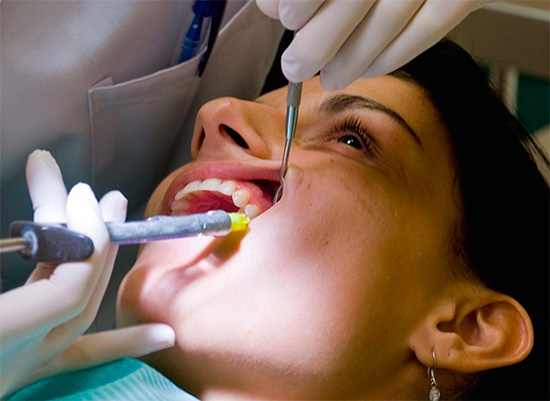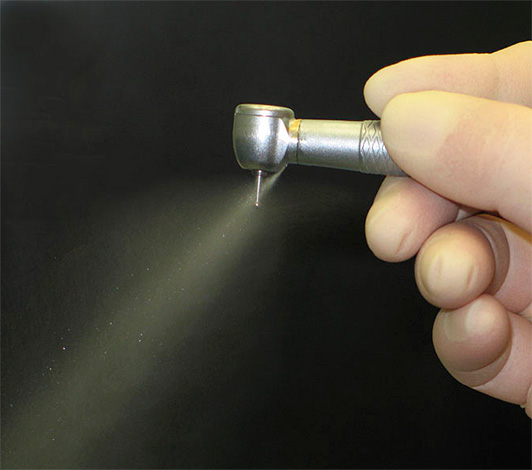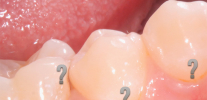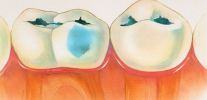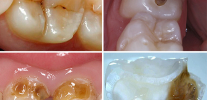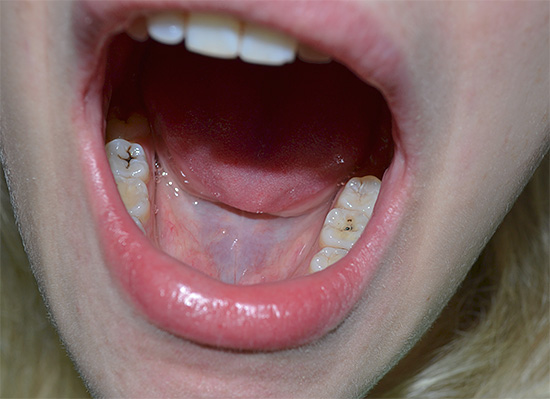
Today, almost every person at a certain stage in his life at least once encounters the problem of caries, which is often accompanied by more or less pronounced toothaches (and some years suffer such periodic pains, drowning them with pills). However, few people know that if nothing is done, then in the last stage of destruction with deep caries, in addition to a variety of pain sensations (from sweet, hot, cold, from solid food), serious development risks appear pulpitis and periodontitis. Such complications of deep caries often cause pain of such force that everyone who has experienced them at least once remembers this for a lifetime.
The photo below shows an example of deep caries, in which the pulp chamber of the tooth is already very likely to be affected:
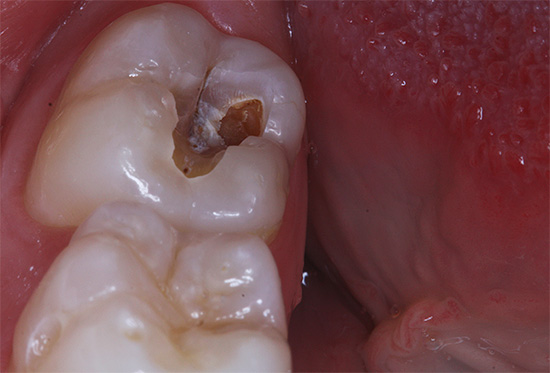
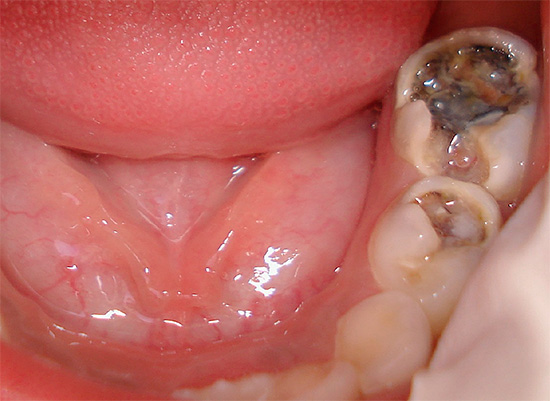
By what symptoms can you understand that deep tooth decay has already formed in the tooth, how to distinguish it from other types of carious lesions and complications, why with deep caries there is a putrid breath and what you need to know about treatment in this situation - these and many other interesting We will talk further about the nuances.
It is interesting
People have been familiar with deep caries since antiquity, as evidenced by the deplorable state of the jaw bones and teeth, which are often found during excavations. In the Middle Ages, it was believed that the disease was generated by “toothworms,” which needed to be removed with a hot iron - as you know, such procedures did not give a special therapeutic effect. Attempts to treat deep caries were made long before that (a few thousand years ago - in ancient Rome), but some success was achieved only after the appearance of the first primitive Morrison drill in the mid-19th century.
The main forms of deep caries
Depending on the course of the disease, acute and chronic forms of deep caries are distinguished.
Acute deep caries characterized by short-term pain from a variety of irritants. Often the cavity has a deep and narrow entrance with a wide base. If you could scrape the walls of such a cavity with something solid (and dentists do it regularly at receptions), you would notice that softened infected and pigmented dentin always abundantly separated from the walls of the cavity.
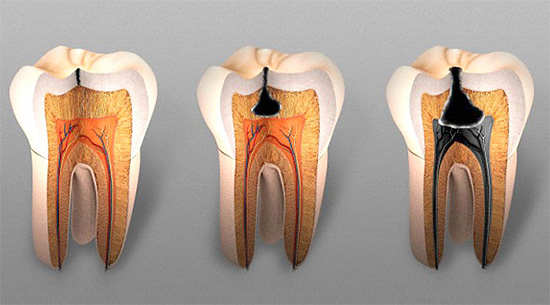
On a note
Since food debris can accumulate for a long time in deep cavities and rot there, this is often accompanied by the appearance of an unpleasant odor from a person’s mouth - even though he seems to be diligently brushing his teeth twice a day.
The following photo shows an example of such a deep carious cavity:
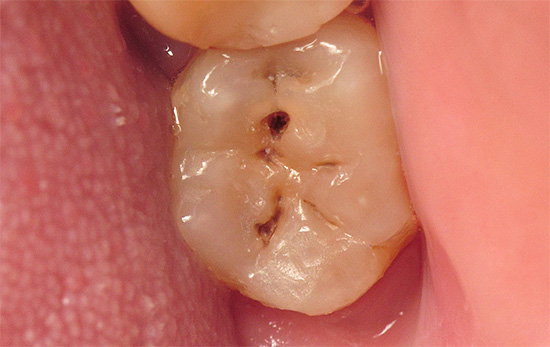
Chronic deep caries, unlike acute, has a sluggish course, so it can often not manifest itself in any symptoms due to the deposition of substitution dentin at the bottom of the carious cavity, which prevents its irritation by food or drinks. The bottom is often dense and even slightly polished. Otherwise, chronic caries is called "suspended".
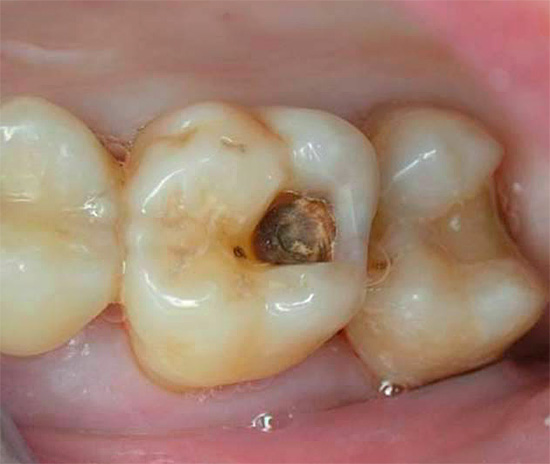
It is interesting
Researchers involved in cariesology believe that even an acute form of deep caries can occur without characteristic symptoms. Even in the presence of a deep cavity with softened dentin, it can be covered by a “shell” of enamel and can remain in a place inaccessible to external irritants for a long time, for example, on one of the contact walls of the tooth near the gums (that is, in the interdental space).Only after a large part of the enamel has been broken off or broken off over the carious cavity is a classic manifestation of acute deep caries possible with a clinic characteristic of this.
Signs of deep caries that are unlikely to "leave anyone indifferent"
Since deep caries is the last stage of carious destruction, it has a clinic characteristic of it only (the same goes for diagnostics and treatment methods). In real life, it can be quite difficult to determine the stage of destruction of hard tooth tissues: medium and deep caries often have few differences.
The following characteristic symptoms of deep caries can be distinguished:
- Pain when taking cold and hot (i.e. from temperature factors);
- Pain from sugary foods, acidic foods or salty foods (chemical factor);
- Pain when hard food enters the carious cavity of the tooth (mechanical factor).
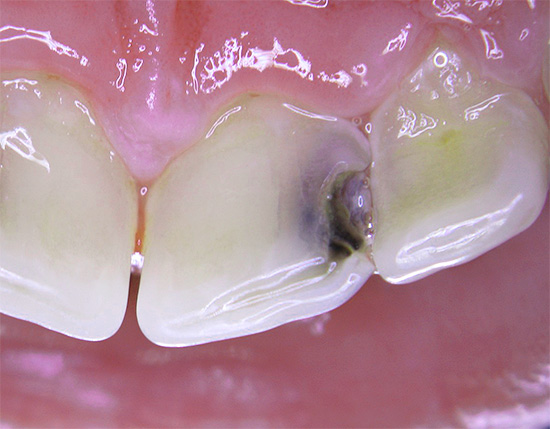
Such a clinic of deep caries is typical for most cases. When sweet or cold gets on a bad tooth, a sharp pain occurs, which lasts only as long as the irritant acts.
Unfortunately, short-term pain for many people is a great opportunity not to go to the doctor's office and wait a little longer. And they really wait, for months - until the onset of acute pain characteristic of pulpitis or periodontitis, when without strong pills for toothache about a full life can no longer be considered.
Photo of a tooth with a deep carious cavity, which led to the development of pulpitis:
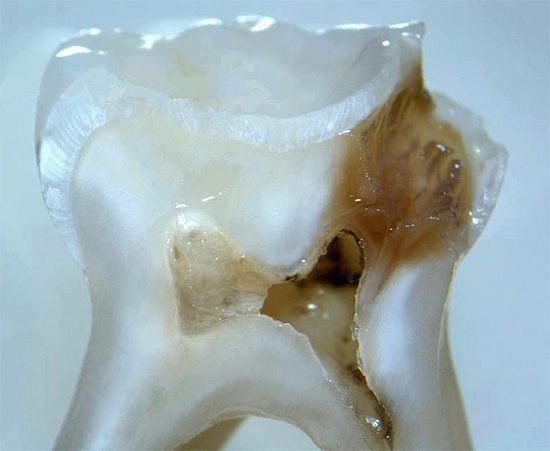
Feedback
About a year ago, I felt that my lower molar on the left began to decay and began to react strongly to the cold. I wasn’t particularly sick, so I didn’t go to the dentist, but after a couple of months the tooth began to react literally to everything: sweets, hot tea, milk from the refrigerator and even fruit and chewing meat. Based on these symptoms, I was diagnosed with deep caries and was lucky that the treatment cost one visit. But the doctor warned me that after treatment it is necessary to ensure that pain does not appear again in the tooth. Thank God, but for a year now he has not bothered.
Elizabeth, Pyatigorsk
Photo of deep caries on the front tooth:
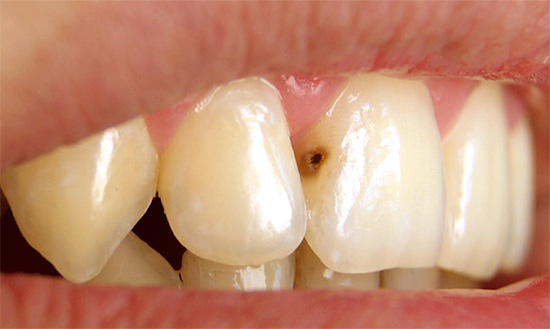
Self-diagnosis for the correct diagnosis
If you want to make sure that the pain in your tooth is associated with deep caries, and not with something else, then you can try to conduct an independent differential diagnosis. First of all, you need to make sure that this is not pulpitis: with caries, the dental nerve is still intact, and with pulpitis, the bacteria have already made their way into the pulp chamber and are slowly destroying soft tissues here. Accordingly, in the first case, treatment will only threaten with the installation of a seal, and in the second, it will be necessary to remove the “nerve”, clean the canals, fill them, etc., that is, the procedure will be much more complicated (and expensive).
- In acute pulpitis, the pains are acute and spontaneous (especially at night), that is, they arise on their own, in contrast to deep caries, in which the pain occurs only from external irritants.
- With deep caries, the pain from irritants passes quickly, and with pulpitis, the tooth aches for a long time.
- At chronic pulpitis the carious cavity can communicate with the pulp chamber, therefore, when food is ingested, severe pain often occurs that does not pass for a long time.
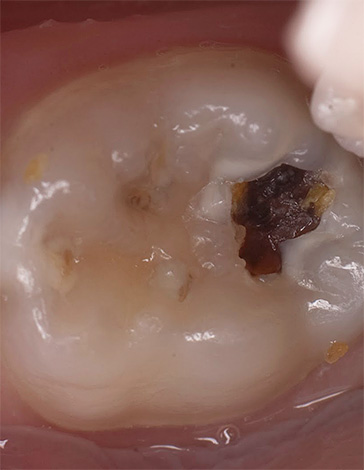
Dentist's advice
Of course, only a doctor should make an accurate diagnosis. However, since we started self-diagnosis ... There is another way to diagnose deep caries: you can temporarily close the deep carious cavity with a cotton ball (if possible). If the pain disappears during the day or becomes insignificant - with a high degree of probability you have deep caries.With complications of caries (pulpitis or periodontitis), pain after closing the cavity from external irritants with a cotton swab remains at the same level or even intensifies.
Modern diagnostic methods
At the dentist’s appointment, the correct diagnosis can be made with 100% accuracy using various methods of differential diagnosis of deep caries.
Visual diagnosis. It is perhaps the most common form of diagnosis and is usually performed using a dental mirror and probe. In this case, the depth of the cavity is estimated, its shape and dentin hardness at the bottom and walls.
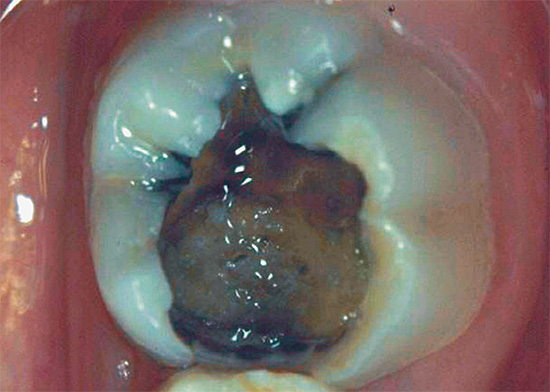
Generally, with deep caries, sounding is painful throughout the bottom. The pulp chamber (the place where the tooth "nerve" is) is not opened. In the acute form of pulpitis, sounding is often painful only at one point, and in chronic forms, the pulp can even be opened, and the “nerve” during the sounding can bleed painfully.
The photo shows the tools used for visual diagnosis of deep caries:
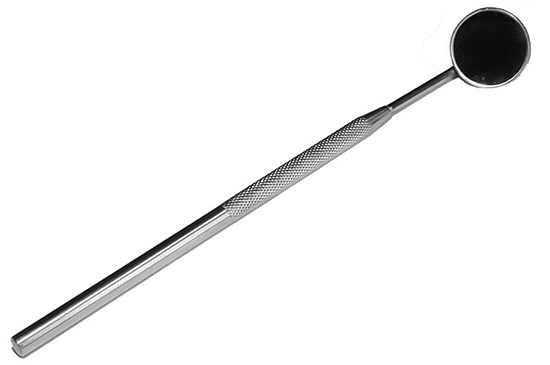
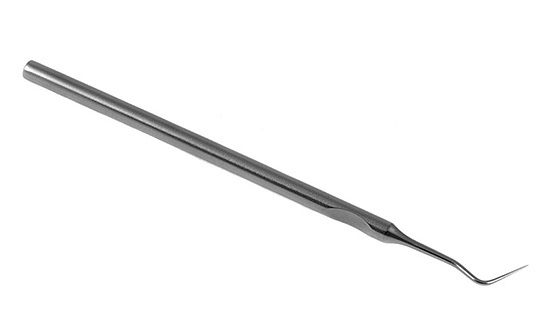
Electroodontodiagnosis (EDI) or, otherwise, electroodontometry. This method is a very informative way to determine the state of soft tissues inside the tooth using weak electric currents.
The doctor evaluates the current strength to which the tooth reacts when carrying out the technique. With deep caries, during the EDI, the tooth already begins to respond to a current of 2 to 6 μA, less often - 10 μA.
In acute forms of pulpitis, the tooth reacts only with a current strength of more than 15-20 μA, and in chronic forms - more than 50-60 μA. A tooth with periodontitis is sensitive to a current of 100 μA and above. Electroodontometry devices: for example, EOM-1, OD-2M, OSM-50, etc.
The photo below shows the device for EDI:
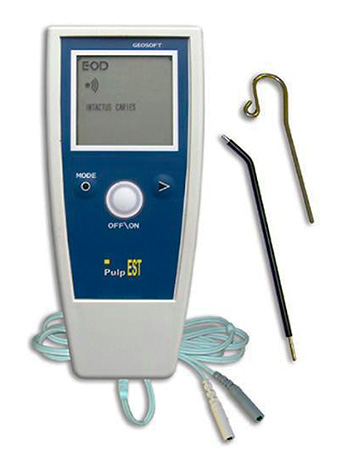
From the observations of the dentist
When conducting EDI of deep caries, the value of nerve excitability is often determined by the current strength of 15-20 μA. Generally speaking, this is a transitional form when latent inflammatory phenomena in the pulp chamber may begin, or they may not be. In such cases, the doctor carries out according to the protocol for the treatment of caries all measures related to cleansing the carious cavity from necrotic tissues and does not put a permanent filling, limited to a temporary dressing without medication for up to 1-2 weeks.
The patient is warned that if a tooth closed with a temporary filling will hurt the next day, you should immediately come to treat pulpitis. If the tooth does not react to anything during the inspection period, then the next visit will be permanently filled with a diagnosis of deep caries.
X-ray - allows you to find hidden deep carious cavities. The most popular at present is the so-called contact radiography, when an aim picture is taken, covering 1-3 teeth. Such data can be obtained on modern devices - visiographs. For information, a problematic tooth (teeth) is often enlarged in pictures, which makes it possible to assess the depth of the carious cavity.
The photographs below show a radiographic image of teeth with a hidden deep carious cavity:
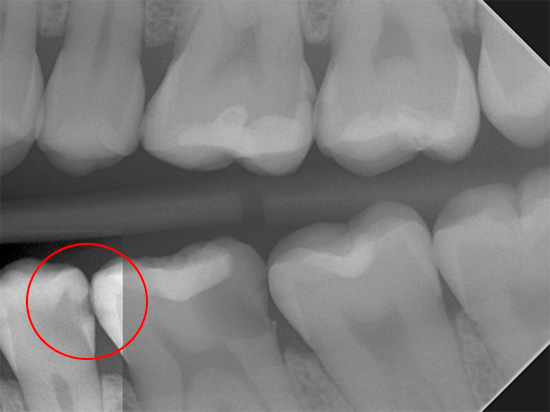
X-rays easily pass through softened with caries tissue, and a dark spot of a certain area is visualized in the image in proportion to the size of the cavity. The message of such a “spot” in a picture with a pulp chamber almost always indicates inflammation of the “nerve” and the development of a complication of deep caries - pulpitis.
Techniques for the treatment of deep caries and the materials used for this
The treatment of deep caries has its own characteristic features. The exceptional proximity of dentin at the bottom of the cavity to the pulp chamber of the tooth requires the dentist to adhere to the following rules:
- Mandatory anesthesia (anesthesia) of the tooth.It is impossible to carry out treatment without an “injection”, since the depth of the cavity and the proximity of the pulp cause a different nature of pain when treating a tooth with a drill, sometimes very strong.

- Mandatory air-water cooling when treating a cavity with a drill. In this case, a 4-channel turbine tip with improved water supply qualities should be used. Modern modified versions of the tips have numerous channels for jet water supply to the tooth and even the possibility of lateral cooling of the tooth. The better the tooth cools during processing, the less risk that it accidentally overheats, and in the future complications will arise under a permanent seal.

- Tooth treatment using special pasting pads to relieve possible inflammation, restore tissue layer (new healthy dentin) over the “nerve”, bactericidal effect and to prevent complications of caries in the form of pulpitis. Most often, in the treatment of deep caries, medical pads based on calcium hydroxide are used (Calcin, Calmecin, Calcipulpe, Dycal, etc.). Sometimes used gaskets based on eugenol (zinc-eugenol cement, Cavitec, Eugespad, etc.). Less commonly used are combined formulations.
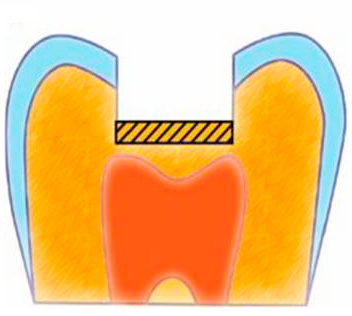
The main stages of the treatment of the carious cavity with deep caries is:
- opening the cavity and removing the overhanging edges of the enamel
- manual or machine cleansing of softened and infected tissues
- cavity formation for the material that will be used for permanent filling
- drug treatment of the formed cavity with weak solutions of antiseptics (for example, 2% chlorhexidine)
- filling with pre-selected material.
The photograph below shows an example of an already formed cavity during the treatment of deep caries:
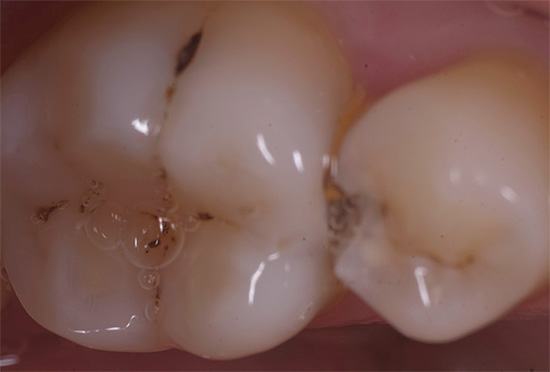
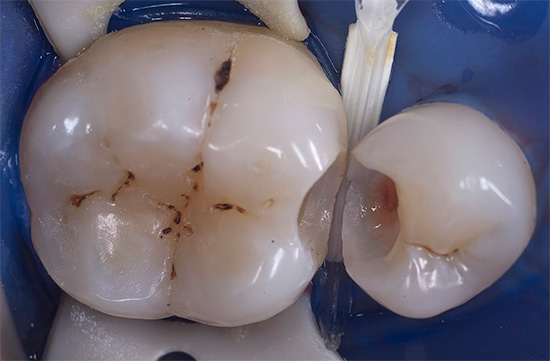
Dentist Opinion
Currently, there are two different positions regarding the use of medical pads for the treatment of deep caries (pads are needed to protect the pulp chamber of the tooth from the toxic effects of filling materials). Many dentists are of the opinion that medical treatment can and should be placed to prevent complications. Another dental school, as opposed to the first, provides arguments for not using medical pads, but confining ourselves to insulating materials (for example, based on glass ionomer cements) and immediately putting modern filling materials in one visit.
Most dentists do not deny the fact that it is not forbidden to put a medical gasket for deep caries under a temporary filling for the required treatment period (from several days to 2-3 weeks) until its therapeutic effect has a positive role. And on the second visit, the dentist can safely put a permanent seal.
Modern materials used as fillings for deep caries:
- composites
- glass ionomer cements (limited)
- compomers
- ormocers (organically modified ceramics)
and some others.
Most modern materials suggest the use of glass ionomer cements (SIC) as insulating gaskets, since they release fluorides into tooth tissues for a long time, providing an additional anti-carious effect.
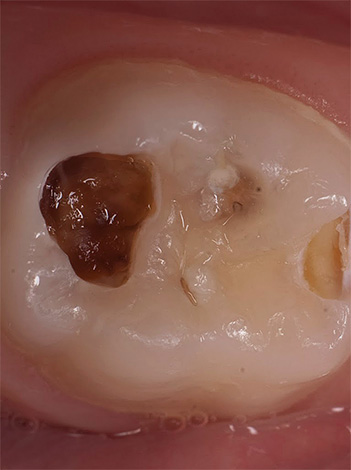
The deeper - the more expensive?
Currently, the pricing policy of most dental clinics is largely determined by the depth of the carious lesion, as deep caries consumes more expensive material than, for example, on average. And some firms to determine the cost of treatment are guided only by the location of the deep carious cavity according to the Black classes (1, 2, 3, 4 and 5).
Most often, the emphasis is on the depth and area of the lesion, so you will have to pay more for the last stage of the carious process than for the first three.That is why caries treatment should be started not at the stage when it already threatens to develop into pulpitis, but when the first signs of the disease are detected (spot, roughness, slightest pain).
Still waiting for the pill to relieve toothache again? Meanwhile, the bacteria are getting closer and closer to the pulp chamber of the tooth, and yet they will destroy everything there if they get there. So do not hesitate, and run to the dental clinic!
But what awaits you in the treatment of deep caries ...
Treatment methods for deep caries

